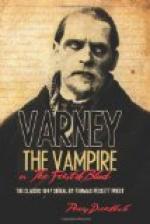“Let us examine,” said George.
There were shelves or niches built into the walls all round, on which the coffins were placed, so that there could not be much difficulty in a minute examination of them all, the one after the other.
When, however, they came to look, they found that “decay’s offensive fingers” had been more busy than they could have imagined, and that whatever they touched of the earlier coffins crumbled into dust before their very fingers.
In some cases the inscriptions were quite illegible, and, in others, the plates that had borne them had fallen on to the floor of the vault, so that it was impossible to say to which coffin they belonged.
Of course, the more recent and fresh-looking coffins they did not examine, because they could not have anything to do with the object of that melancholy visit.
“We shall arrive at no conclusion,” said George. “All seems to have rotted away among those coffins where we might expect to find the one belonging to Marmaduke Bannerworth, our ancestor.”
“Here is a coffin plate,” said Marchdale, taking one from the floor.
He handed it to Mr. Chillingworth, who, upon an inspection of it, close to the light, exclaimed,—
“It must have belonged to the coffin you seek.”
“What says it?”
“Ye mortale remains of Marmaduke Bannerworth, Yeoman. God reste his soule. A.D. 1540.”
“It is the plate belonging to his coffin,” said Henry, “and now our search is fruitless.”
“It is so, indeed,” exclaimed George, “for how can we tell to which of the coffins that have lost the plates this one really belongs?”
“I should not be so hopeless,” said Marchdale. “I have, from time to time, in the pursuit of antiquarian lore, which I was once fond of, entered many vaults, and I have always observed that an inner coffin of metal was sound and good, while the outer one of wood had rotted away, and yielded at once to the touch of the first hand that was laid upon it.”
“But, admitting that to be the case,” said Henry, “how does that assist us in the identification of a coffin?”
“I have always, in my experience, found the name and rank of the deceased engraved upon the lid of the inner coffin, as well as being set forth in a much more perishable manner on the plate which was secured to the outer one.”
“He is right,” said Mr. Chillingworth. “I wonder we never thought of that. If your ancestor was buried in a leaden coffin, there will be no difficulty in finding which it is.”
Henry seized the light, and proceeding to one of the coffins, which seemed to be a mass of decay, he pulled away some of the rotted wood work, and then suddenly exclaimed,—
“You are quite right. Here is a firm strong leaden coffin within, which, although quite black, does not otherwise appear to have suffered.”
“What is the inscription on that?” said George.




